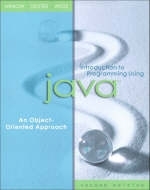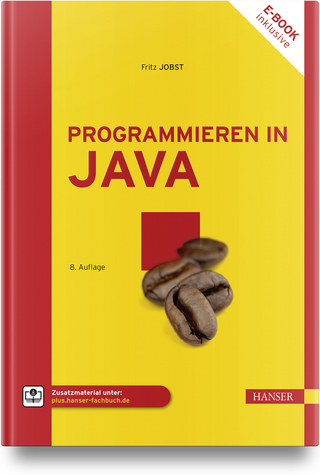
Introduction to Programming Using Java
Pearson (Verlag)
978-0-321-22346-3 (ISBN)
- Titel ist leider vergriffen;
keine Neuauflage - Artikel merken
Introduction to Programming Using Java offers an object-oriented approach, introducing the concepts of object, class, and message as early as the first chapter. This approach is used throughout the text as students learn the fundamentals of object-oriented programming along with the basics of imperative programming. The authors place a strong emphasis on the software development process, presenting a clear and usable procedure for solving problems by developing classes.
1. Jumping Into Java.
Computers and Programs.
Programs and Models.
Objects, Classes, and Messages.
Our First Object: A PrintStream.
Sending a Message to the System.out Object.
A Java Program.
IDENTIFIERS, STATEMENT ORDER, FORMAT, AND COMMENTS.
Mechanics.
Time.
Summary.
Study Aid: Terminology Review.
Questions for Review.
Further Exercises.
INTRODUCTION: WEB PAGES, HTML, AND APPLETS.
2. Sending Messages and Performing Operations.
Introduction.
Using PrintStream Objects.
REFERENCES, METHODS, AND MESSAGES.
The String Class.
Methods, Arguments, and Return Values.
Reference Variables.
VARIABLES AND ASSIGNMENT.
Using String Methods.
Imperative Programming: Doing the Work.
Examples.
JAVA INTERLUDE: String OBJECTS AND THE + OPERATOR.
Study Aid: Terminology Review.
Questions for Review.
Further Exercises.
PAINTING AND POSITIONING GRAPHICS.
3. Working with Objects and Primitive Types.
Introduction.
Creating Objects.
ORIGINS OF OBJECTS.
Working With Objects.
Dates and Calendars.
BigInteger.
Introduction to Input.
The File Input Process.
Keyboard Input.
File Output.
Network Computing: An Introduction.
Summary.
Study Aid: Terminology Review.
Questions for Review.
Further Exercises.
TOWARDS ANIMATION.
4. Defining Classes.
Introduction.
Class Definition: Methods.
Class Definition: Instance Variables.
More on Methods: Return Values.
Imperative Programming: Finding the Minimum.
VARIABLES, DECLARATIONS, AND THE return STATEMENT.
Still More on Methods: Parameters.
State and Behavior.
Class Definition: Putting it All Together.
DECLARATIONS, ACCESS, AND OBJECTS.
Summary.
Study Aid: Terminology Review.
Questions for Review.
Further Exercises.
A SIMPLE ANIMATION.
5. Advanced Class Definition.
Customizing New Objects: Constructors.
CONSTRUCTORS, INITIALIZERS, AND OVERLOADING.
Example: A Name Class.
Providing Class Behaviors.
STATIC METHODS.
Tracking Class-wide Information: Static Variables.
Defining Constant Values: final.
WORKING WITH OBJECTS.
Input Methods Revisited: Testing for End of Input.
SUMMARY.
TERMINOLOGY REVIEW.
Questions for Review.
Further Exercises.
CREATING CONTROLS AND INTERACTION.
6. Inside the Method: Imperative Programming.
Introduction.
A Metric Conversion Class.
float, double, AND THE for STATEMENT.
Approximating the Value of p.
Cascaded and Compound Conditional Statements.
LOGICAL OPERATORS AND CONDITIONAL STATEMENTS.
Summary.
Study Aid: Terminology Review.
Questions for Review.
Further Exercises.
MORE ON INTERACTION.
7. Designing Classes.
Introduction.
Designing Classes-An Overview.
The Counter Class Revisited.
An Automated Teller Machine.
Dispatching Repairpeople: An Example.
Summary.
Questions for Review.
Further Exercises.
MULTIPLE CONTROLS: LAYOUT AND EVENT HANDLING.
8. Verifying Object Behavior.
Introduction.
Categories of Errors.
JAVA'S ASSERTION FACILITY.
Test Drivers.
Automatic Testing.
What to Test and How to Test It.
Debugging Techniques.
Summary.
Study Aid: Terminology Review.
Questions for Review.
Further Exercises.
SEPARATING DISPLAY AND CONTROL.
9. Working with Multiple Objects.
Introduction.
Processing Multiple Objects.
Loop Patterns.
The Impact of Loops on Testing.
A Telephone Book.
Maintaining Multiple Values.
Vector-A Simple Collection Class.
Traversing Vectors Using for Loops.
Revisiting the TelephoneBook Class.
PRIMITIVE TYPES AND COLLECTIONS; REVISITING THE WRAPPER.
CLASSES.
An Example-Determining a Student's Relative Performance.
Another Vector Application.
Object METHODS.
Introducing Arrays.
Vectors and Arrays.
Summary.
Study Aid: Terminology Review.
Questions for Review.
Further Exercises.
POSITIONING TEXT.
10. Designing Iteration.
Introduction.
Designing Loops.
JAVA INTERLUDE: TWO LOOP STATEMENTS.
Another Simple Example.
Revisiting the Loop Patterns of Chapter.
Variations on the Repairperson Loop.
More Loop Patterns: Counters, Accumulators, and Extremes.
SHORT CIRCUITS, break AND continue.
A Loop Design Strategy: Refining an Imperfect Solution.
The Radio Station's Play Schedule.
Example: The LOGO Turtle.
Summary.
Study Aid: Terminology Review.
Questions for Review.
Further Exercises.
MORE TEXT MANIPULATION.
11. Maintaining Collections of Objects.
Overview.
Searching.
Binary Search.
Finding the Index of an Extreme.
Sorting.
Summary.
Study Aid: Terminology Review.
Questions for ReviEW.
Further Exercises.
THREADS.
12. Extending Class Behavior.
Introduction.
Extending Classes-Inheritance I.
A Better BufferedReader.
Adding State to the Subclass-Accessing the Superclass's State.
Revisiting the Name Class-Adding Additional State.
INHERITANCE.
Overriding Methods.
POLYMORPHISM.
Factoring out Common Behavior-Inheritance II.
Abstract Methods and Classes.
Specifying Common Behavior-Interfaces.
A Generic Sorting Method.
Summary.
Study Aid: Terminology Review.
Questions for Review.
Further Exercises.
EXPLORING THE AWT PORTION OF THE JAVA CLASS HIERARCHY.
13. Exceptions.
Expect the Unexpected.
Encountering the Unexpected.
THE Exception CLASS.
Handling the Unexpected.
Responsibility for the Unexpected.
Exceptions Are Not Always Errors.
Summary.
Study Aid: Terminology Review.
Questions for Review.
Further Exercises.
THE MODEL-VIEW-CONTROLLER (MVC) PARADIGM.
14. Recursion.
Introduction.
Example: Exponentiation.
How to Design a Recursive Method.
Recursive Methods: Under the Hood.
Recursion with Vectors, Arrays,and Strings.
Permutations.
Towers of Hanoi.
Recursion and Iteration.
Summary.
Questions for Review.
Study Aid: Terminology Review.
Further Exercises.
TOWERS OF HANOI APPLET.
15. Client/Server Computing.
Clients and Servers.
Internet Communication.
Client-Server Computing.
Some Simple Client Classes.
SWING.
| Erscheint lt. Verlag | 4.9.2003 |
|---|---|
| Sprache | englisch |
| Maße | 188 x 231 mm |
| Gewicht | 1070 g |
| Themenwelt | Informatik ► Programmiersprachen / -werkzeuge ► Java |
| Mathematik / Informatik ► Informatik ► Web / Internet | |
| ISBN-10 | 0-321-22346-2 / 0321223462 |
| ISBN-13 | 978-0-321-22346-3 / 9780321223463 |
| Zustand | Neuware |
| Informationen gemäß Produktsicherheitsverordnung (GPSR) | |
| Haben Sie eine Frage zum Produkt? |
aus dem Bereich


